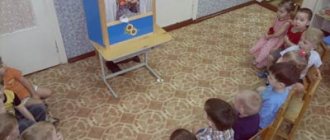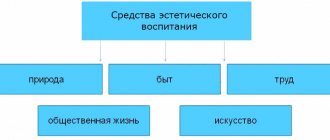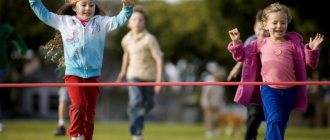The role of folklore in the education of preschool children
The role of folklore in the upbringing of children
Purpose of the material: This article introduces teachers to the importance of folklore for the development and education of preschool children, with experience in this area. The article may be of interest to kindergarten teachers, teachers working with “special” children, and parents. Children's folklore plays an important role in the education of preschool children, the leading feature of which is the unity of poetics, music, manner of performance and function of the work (M.N. Melnikov). Its peculiarity is determined by folk artistic thinking and the requirements of folk pedagogy. For example, in sayings, nursery rhymes, children's songs, and jokes, improvisation, imagery, rhythm and instruction are combined (M.Yu. Novitskaya). This is a kind of school of play, designed to provide the child with an adequate way of understanding the world around him (A.M. Martynova). Children's folklore is, first of all, a culture of dialogue; it is focused on interaction, the need to listen and respond. The fairy tale, created for children's edification, was attracted by fiction that carries deep life meaning. Children's calendar folklore provided an intonational, poetic, figurative form of communication with the outside world. Children's folk games, songs, nursery rhymes, jokes, ditties, fables, tongue twisters, conspiracies, pure sayings, counting rhymes, riddles are a means of mental, moral, aesthetic, emotional development of preschool children, they represent the core of children's culture, a universal form of communication between children, children and adults. Today, society is faced with the task of creating conditions for caring and preserving children's language, children's traditions, and children's subculture. We built our work on the following principles: • taking into account the age characteristics of children when selecting content, topics of classes, tasks of education and training; • ensuring emotional and psychological comfort for children; • respect for the personality of each child: Folklore material, taking into account the age capabilities of children, is included in various types of children's activities, enriches the educational and educational process, contributes to the cognitive and emotional development of our students. A long-term plan of activities and entertainment has been drawn up for the group, taking into account the periods of the agricultural folk calendar. The plans include fairy tales, songs, tongue twisters, riddles, boring tales, chants, folk games, lullabies, nursery rhymes, pesters, jokes. All this is present in any type of children’s activity: play, artistic speech, theatrical, educational, and in routine moments. The study of calendar folklore is carried out through the participation of children in calendar holidays. Scenarios of folk holidays are dedicated to different cycles of the agricultural calendar. The organization and holding of national holidays occupy a special place. The holiday is a synthesis of various types of folk collective creativity. Holding folk festivals, gatherings, and evenings is a continuation of the students’ work in thematic classes to introduce them to the origins of Russian folk culture, allowing them to show their initiative and creative potential. In the process of holding the holiday, knowledge is consolidated and expanded, and students apply it in practice, in collective creativity, because the holiday includes a living word, sounds, colors, rhythm, movement, form, i.e. children directly participate in various types of folk art. Not a single ritual holiday is complete, of course, without playing Russian folk instruments. These simple instruments become magical in the hands of children, come to life and find their own voice. Introducing children to new instruments, performing songs and dances on them contributes to their musical development. Since the work is aimed at enriching children with knowledge about folklore, in physical education classes they also turn to Russian folk art. The use of children's folklore in working with children has several directions, but their definition is conditional, because problems are solved in a complex manner. The first direction is the establishment and formation of trusting, kind, affectionate relationships between adults and the child. The main thing in a relationship is a clear manifestation of love and affection. Adults should actively use stroking gestures, which relieve tension and alienation in relationships and help establish contact with the child, filled with good feelings and calm. The second direction is for children to perform various movements when pronouncing folk nursery rhymes, jokes, chants, sayings, etc., which contribute to the development of fine motor skills. The development of fine motor skills and hands is inextricably linked with the mental development of children and the development of their speech. In addition to nursery rhymes and jokes that develop fine motor skills and the child’s hand, we teach him using children’s folklore and various expressive movements. The child learns to be emotional both in speech and in showing movements. Thanks to children's folklore, the emotional sphere of the child is enriched; we help him express emotions that are adequate to the content of the text. A special place in working with children to master the material of children's folklore is given to jokes, fun, and children's joy. In this regard, boring fairy tales and, of course, games, teasers, and humorous dialogues are indispensable. Thus, we see that works of children's folklore are not only diverse in genres, but they are also diverse in themes and tasks. Children's folklore stimulates the child's creative expression and awakens imagination. Creativity enriches the personality, the child’s life becomes more interesting and meaningful. Games based on children's folklore give children extensive experience in the skills of expressive speech and expressive movements. Children realize their experience in theatrical activities. Folklore is close and interesting to children, and we help them, by becoming familiar with folklore, to play and play, gain intelligence, become kinder, understand jokes, humor, and rejoice. Teachers can use children's folklore in individual and group lessons, during leisure hours, and on holidays. Children's folklore will help speech therapists in establishing contact with children and creating favorable conditions for teaching children clear and expressive speech. Music directors also need games with folk words, because They help develop children's sense of rhythm, expressiveness of movements, and creative abilities. The greatest excitement and interest is caused by turning to games. They develop initiative, organizational skills, and resourcefulness. Many ancient games involve singing. It decorates them, promotes quick memorization, and gives rhythmic coherence (“Burn, Burn Clearly,” “Pie,” “Karavai,” “Kostroma,” “Two Grouse”). Folklore is an extremely valuable didactic material in the aesthetic education of the younger generation. Vivid images of good and evil in songs, fairy tales, and choruses are accessible and understandable to children. Moreover, children do not just listen to fairy tales and songs, they themselves are involved in fairy-tale play, they are participants and directors of musical and playful and vocal compositions, fairy tales, and puppet shows. The game corresponds to the nature of the student; In the process of playing, the child organically learns new musical images, acquires skills and abilities, and develops his imagination. Moreover, the development of abilities occurs as if by itself, in an entertaining and exciting form of play, which deprives the educational process of edification. If a child was born and grew up on his native side, among Russian birches, heard Russian songs, sang carols, congratulated his relatives on the bright holiday of Easter, was brought up in work, mercy, kindness, in respect for elders, relatives and the Earth, this commandment of the ancestors is in his soul will save, only bring joy and happiness with it.
We recommend watching:
Scenario of a folklore holiday for schoolchildren Folklore sketch “Bereshchenye” Development of emotionality of young children through familiarity with Russian folklore Development of divergent thinking in first-graders
Similar articles:
Folklore festival in elementary school
School adaptation for first graders
How to organize the educational process in a preschool educational institution
Development of creative abilities of preschool children in theatrical activities
Emotional development of a senior preschooler
Directions for using folklore creativity in a child’s speech development
Folklore is a means that influences various aspects of the personality and helps its full and comprehensive development.
Folklore creativity develops a child’s speech from birth. Speech development based on folklore is carried out in the following areas:
Are you an expert in this subject area? We invite you to become the author of the Directory Working Conditions
- Expanding and enriching the child’s vocabulary. The first songs, nursery rhymes, and nursery rhymes are constructed in such a way that they influence the child’s thinking and the part of his brain that is responsible for speech functioning. Hearing nursery rhymes and nursery rhymes, the child strives to repeat them, since the rhythm of these works and their style activate speech processes. Lullabies form the basis of smooth pronunciation and expand a child’s vocabulary.
- Formation of the articulatory apparatus. The organs of articulation take an active part in speech activity. Also, they are actively used in oral folk art: singing songs, ditties, observing their rhythm, forcing them to perform certain movements with the organs of articulation. This trains them, forms their muscle muscles and develops coherence and rhythm of the articulation organs.
- Formation of phonemic hearing. It is carried out on the basis of listening to various forms of folklore. Folklore and its forms have their own specific characteristics, properties that have a positive effect on auditory perception.
- Sample for writing descriptive stories. Folklore is a model for constructing certain texts: fairy tales, sayings, tongue twisters, etc. This builds and expands verbal communication skills.
Finished works on a similar topic
Course work The role of folklore in the development of verbal communication of children 430 ₽ Abstract The role of folklore in the development of verbal communication of children 270 ₽ Examination The role of folklore in the development of verbal communication of children 230 ₽
Receive completed work or specialist advice on your educational project Find out the cost
Recommendations for using folklore as a means of child speech development
In order for folklore to have the desired effect in a child’s speech development, one should rely on a number of recommendations for its use:
- Acquaintance with folklore from birth. Lullabies, nursery rhymes, and rhymes help in the formation of smooth and clear speech from the very beginning of its formation.
- Using gaming techniques when getting to know folklore. The game best helps in mastering the world around us and its various aspects.
- Explanation of unfamiliar words used in folklore.
- Explanation of fairy tales and other forms of folklore in your own words. This simplifies children’s understanding of the essence of the work and guides them towards developing grammatically correct speech.
- Emotional presentation of folklore.
- Motivation for getting acquainted with oral folk art.
Get paid for your student work
Coursework, abstracts or other works
The use of riddles in the speech development of children
Riddles have a positive impact on the development of a preschooler’s thinking and shape his speech in the following aspects:
- Expanding a preschooler's vocabulary due to the ambiguity of concepts used in riddles. Children learn words and their different meanings, as well as the use of literal and figurative meanings of words in their verbal communication;
- Mastering the grammatical structure of speech. The riddle forms the child’s idea of how to construct sentences correctly, observing all the rules. The linguistic form of riddles motivates to analyze the structure of words and sentences;
- Mastering the sound side of speech. There is a development of auditory perception of speech, its meaning, presentation in various forms, using expressive language means;
- Formation of correct diction of a child. When pronouncing riddles, speech becomes concise and grammatically correct. This develops the skills of clear pronunciation and concise expression of one’s thoughts.
The use of proverbs and sayings in a child’s speech development
Proverbs and sayings are a type of poetic creativity that contains the wisdom of the people accumulated over centuries.
Proverbs and sayings are actively used as a means of speech development for preschool children. In addition, they find application in speech therapy practice, i.e. used in speech development correction programs.
The use of proverbs and sayings as a means of developing the speech of a preschooler contributes to the achievement of the following tasks of speech development:
- Formation of laconic speech;
- Clarity of pronunciation;
- Clarity and brightness of speech, expression of thoughts and feelings;
- Giving speech a scientific flavor;
- Formation of the foundations of creative orientation in the use of various speech structures;
- Formation of the foundations of imaginative thinking and imaginative description of various objects, processes and phenomena of the surrounding world;
- Giving the text describing something brightness and emotional richness.
The use of proverbs and sayings should be implemented on the basis of the principle of transition from simple to complex, i.e. you need to start by studying simple proverbs and sayings, gradually complicating them. This will make it easier for children to understand their meaning and meaning, as well as their place in the speech process.
At the final stage of working with proverbs and sayings, the creative direction of the activity is realized. It involves children composing proverbs and sayings on a specific topic, with a specific meaning.
When studying proverbs and sayings, it is good to use drawing them and writing stories based on them. This makes learning more fun and goal-oriented. The child strives to understand the meaning of proverbs and sayings and their correct use in his own speech.



